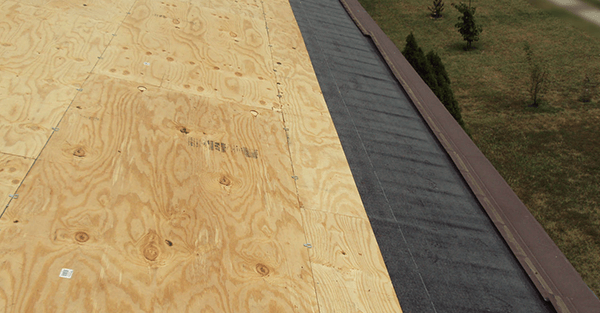
The purpose of shingle underlayment is to provide a protective barrier between the roof frame and shingles of your home. Even though you most likely won’t be installing your roof on your own, you should still be aware of the different types of materials available in order to select the best type of underlayment for your home. Making the right decision can extend the life of your roof and minimize the need for maintenance and repairs.
Underlayment Options
Felt:
This type of underlayment is usually made up of organic felt and saturated with asphalt. It may contain a fiberglass reinforcement to increase strength and longevity. Asphalt-saturated felt is water-resistant for a time, but it eventually wears down and becomes penetrable. The more asphalt used to saturate the material, the more durable and expensive the underlayment. Asphalt is the most expensive component of the roofing process, so lower priced underlayment will potentially contain less asphalt and be of lesser quality.
Felt underlayment is usually more useful for steep-sloping roofs, where water can quickly run off, as opposed to flatter roofs, where water can stand for long periods of time. Generally speaking, it wrinkles easily, can absorb water over time, and isn’t very tear-resistant. Direct sunlight can accelerate deterioration as the asphalt is depleted. While it’s less expensive than other kinds of underlayment, it may not be your best option if you’re looking for quality, durability, and total water resistance.
Rubberized:
There are various types of underlayment made with rubber-like material. “Rubberized” asphalt can be polymer-modified with bitumen (a viscous mixture of hydrocarbons), giving it rubber or plastic properties. Rubberized asphalt is self-sealing and, due to its flexible and elastic nature, able to fill in space around nails or staples. This type of underlayment is better suited for high temperature climates than felt. It can also be very resistant to weathering and moisture penetration.
Synthetic:
Synthetic underlayment is more popular but also tends to be more expensive. It is fully waterproof, adding a highly protective layer of insulation between your roof frame and shingles. Overall, this type receives better safety ratings than felt. It is also more breathable, allowing humidity to escape while resisting water penetration. Synthetic underlayment protects against wind, rain, and ice and is great for low-sloping roofs and shingles. It is durable and long lasting due to its higher percentage of asphalt and polymer modifier. Non-bitumen synthetics are made from polyethylene or polypropylene. Synthetic underlayment is lightweight, wrinkle-free, fungus-resistant, and stands strong under direct UV radiation.
Fire-Resistance Ratings
Another important factor to consider is the underlayment's fire-resistance rating. Be sure to check this when choosing materials. Most underlayment products provide close to the same amount of protection from smoke, but flame protection can differ greatly. You should find a rating of A, B, or C, with A being the best (most fire-resistant) and C being the worst (least fire-resistant).
In the grand scheme of things, when it comes to roofing, the pricing of your underlayment won’t make or break your budget. Looking solely at underlayment options, you’ll see pricing differences probably up to a few hundred dollars. Compare those few hundred dollars to the thousands your total roofing project will cost you. You will see that choosing a higher quality, more durable, and water-resistant underlayment may well be worth the extra cost.
Hedrick Construction is your Ankeny and Ames shingle underlayment source for guidance and installment needs. We will help you determine which type of underlayment is best for you.








Comments